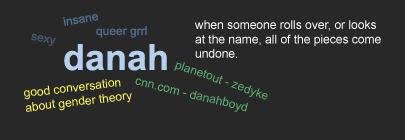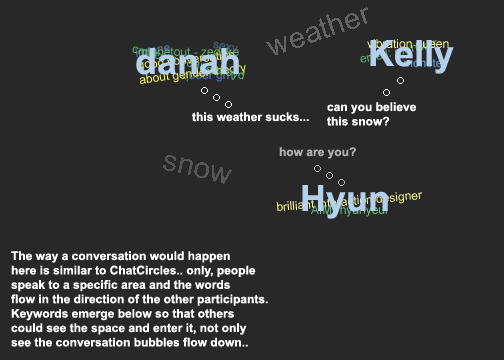One of the most important elements of a chatroom conversation is the people and their relationship between one another. In particular, i am interested in how to represent people in their conversations.
I am fascinated by the relationship of the intimate stranger - those that you know based on experience but don't really know... the brief interactions and what it takes to build up a relationship. When does one break into actually getting to know someone rather than just knowing that they share a similar space? How can this be utilized online? For example, imagine if you came into a chatroom and you found out that another person in there was also with you when you were chatting in a different room under different names.. or was with you when you were exploring a cool website. This gives some context for conversation. Also, imagine if you could write on people, mark up who they are in reference to you, keep a diary of context, references of information that are pertinent to your relationship with the individual at hand. In other words, rather than building up global profiles, build up relationship profiles.


[Warning to Judith & Hyun: my mind is currently wrapped around the ideas we are using for Loom2 so my design is very much in that vain.. sorry.. only so much creativity to go around right now...]
First, i want to answer some of the main questions of this assignment based on what i envision is appropriate for my graphical conversation:
How are the participants represented - name? image? voice? How do they control their representation? Is it static or a source of expression?
I envision a participant being represented by a combination of one's name and other information, sort-of a cluster of information which constructs a virtual body of information. I believe that there is a lot of power in a representation, which is what motivates the idea of an image. I also believe that a flat picture is harmful to interaction and that given current technology, animated version of people are not reasonable. I believe that the in-between requires users to "get over" the stereotypes they build around the image rather than give them a starting point from which to build. Because i feel its unreasonable to pack information into the image, and because i think that people are unable to remember that much data about one another, i think that the image should be the information, a combination of information put forward by the represented and information marked by the viewer. This representation is constantly being altered and updated.
(I am biased; i don't like the phone so i am ignoring the idea of voice...)
How are their words displayed? Can they be directed at individuals or groups? Can small conversations- or threads - form?
I envision words coming out of people as though they are coming out of their representations, directed at specific people and within groups.
How is space used? Do areas of the screen have special meaning? What motivates a person to move about?
People can move around a physical space, kinda like ChatCircles. I envision
a hearing range and all.. people move to different spaces because the
conversations happening there look more interesting.. tidbits of conversations
are displayed visually as well as the awareness that conversations are
happening.. Very similar to CC.

The main crucial changes that i see are that the area starts to show history, as though the information affects what the space is like.. this information is readable by everyone to see how a space is being used and affected. It also serves as a way for people to see what area they might be interested in visiting.